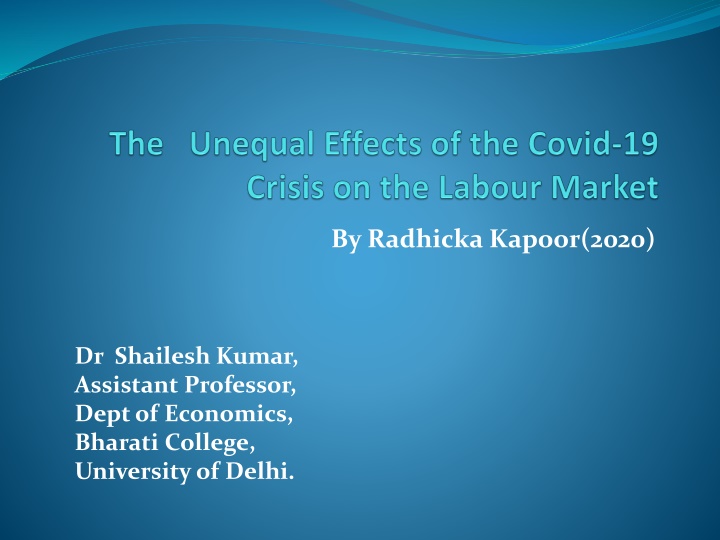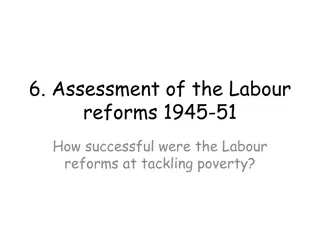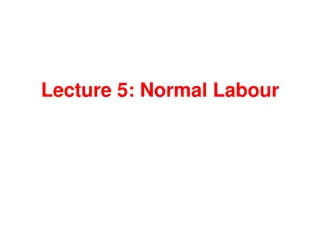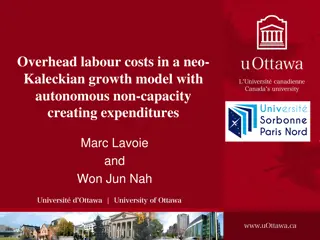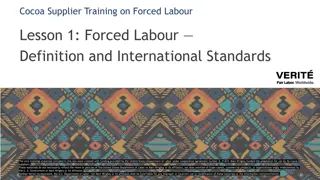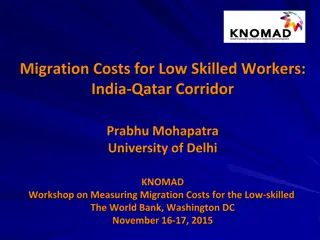Impact of Pandemic on India's Dualistic Labour Market
The pandemic and lockdown have exacerbated inequalities in India's labour market, affecting different worker groups unequally. Self-employed, casual workers, and regular formal workers face varying degrees of job insecurity and lack of social protection. Only a small percentage of workers have access to all social security benefits, highlighting the challenges faced by the workforce in obtaining good jobs or decent work.
Download Presentation

Please find below an Image/Link to download the presentation.
The content on the website is provided AS IS for your information and personal use only. It may not be sold, licensed, or shared on other websites without obtaining consent from the author.If you encounter any issues during the download, it is possible that the publisher has removed the file from their server.
You are allowed to download the files provided on this website for personal or commercial use, subject to the condition that they are used lawfully. All files are the property of their respective owners.
The content on the website is provided AS IS for your information and personal use only. It may not be sold, licensed, or shared on other websites without obtaining consent from the author.
E N D
Presentation Transcript
By Radhicka Kapoor(2020) Dr Shailesh Kumar, Assistant Professor, Dept of Economics, Bharati College, University of Delhi.
Introduction The widespread loss of jobs and incomes following the dual shocks of the pandemic and the lockdown have generated much concern. What is particularly worrying is that the impact of these shocks is not likely to have been uniform across the workforce. The effects of the shocks would be particularly harsh on specific groups of workers. These would be the less- educated workers who are typically engaged in low paying, precarious and unstable work arrangements in sectors that have been hardest hit by the shocks.
Therefore, we can expect the crisis to accentuate the pre-existing inequalities in India s dualistic labour market, which has been characterized by stark disparities between, at one end, a small percentage of the workforce that is engaged in jobs that offer stability of income and social security benefits, and, at the other end, a disproportionately large proportion engaged in informal employment
The labour force data IN 1918-1919 Self Employed- 52% of the workforce were classified as self-employed. 95% of self employed are own account workers (those who operate enterprises without hired labour or unpaid family workers). Lessthan 5% of the self-employed were classified as employers(those who operated enterprises with hired labour) Casual Workers - 24% of the workforce were employed as casual workers with no stability of income or security of tenure. Regular wage salaried (RWS) workers constituted the remaining 24% of the workforce.
Regular formal workers Regular wage salaried (RWS) workers -These workers received a salary on a regular basis and not on the basis of daily or periodic renewal of a work contract. This made them better off than casual workers. In 2018 19 only 40.6% of the RWS workers had access to at least one social security benefit ( provident fund/pension, gratuity, health care, or maternity benefits) and therefore they had a minimal degree of social protection. These workers referred to as regular formal workers accounted for 9.6% of the total workforce.
Good job or decent work. Only 17.7% of RWS workers had access to all available forms of social security cover. This, in turn, means that a mere 4.2% of the total workforce had jobs that offered them the maximum possible protection that often described as a good job or decent work .
Casual workers Casual workers, who on average earn Rs 209 a day, are clearly at the bottom of the pyramid. The financial vulnerability of casual workers is exacerbated by the fact that they are unlikely to get work every day and are therefore not likely to earn the bare minimum needed for the month. A sudden loss of income for those who have such low levels of earnings is likely to be devastating and will push them deeper into poverty
hierarchical order of labour force On the basis of earnings and access to social security, the four basic forms of employment described above fall into a hierarchical order: regular formal employment, regular informal employment, self-employment, and Casual employment That just a small proportion of workers is engaged in what is described as the best form of employment (and that too based on a very relaxed definition of formal employment- i. e. they have access to at least one social security benefits) is reflective of the overall conditions of the quality of employment.
Educational background-1 In 2018 19, more than 50% of those in regular formal jobs were graduates or post-graduates . In contrast, most self-employed and casual workers had low levels of education. For instance, 25.7% of the self-employed were not literate and 80% had secondary education or below. Amongst casual workers, the share of those who were not literate was 37% and those who had secondary education or below was over 90%. That it is the relatively less educated who are predominantly engaged in precarious work arrangements and therefore have a high probability of being rendered. unemployed suggests that they stand to bear a disproportionate brunt of the Covid-19 shock.
different Sectors 2-unemployment Furthermore, the less educated are typically employed in sectors where the first order effects of the pandemic have been severe and the options for remote work are either limited or do not exist. Outside of the agricultural sector, which accounts for 42.2% of total employment, the three sectors which cumulatively account for approximately 36% of total employment are manufacturing, construction and trade, and hotels and restaurants. These sectors have been significantly affected by the pandemic and the lockdown and other containment policies, due to both supply-side disruptions and a fall or collapse of demand
Educational status in different Sectors 3 over 90% of workers in construction have secondary education or below. In the manufacturing sector and the trade, hotels and restaurants sector the corresponding statistics stood at 76% and 70%, respectively. these sectors are also dominated by informal and precarious work arrangements. This makes workers engaged in these sectors highly vulnerable to layoffs. In the construction sector over 80% of the workers are in casual employment and therefore can be fired easily. In the manufacturing sector, too, almost 85% are in informal work arrangements. In the trade, hotels and restaurant segment, less than 5% are in regular formal jobs.
high-end services sectors In contrast, high-end services sectors (such as finance, business, real estate and public administration, health, and education) are more amenable to remote work and have a higher share of regular formal employment. the share of casual workers in these sectors is less than 5%. These sectors offer more secure terms of employment and they also pay higher wages. This gives workers a greater financial wherewithal to cope with any loss of earnings or periods of unemployment. Furthermore, these sectors largely generate employment opportunities for those at the top end of the education ladder .
Nature of impact of Covid-1 That the impact of the Covid-19 crisis on workers varies and depends on the nature of the employment arrangement and the sector of employment, suggests that we are likely to see increasing inequality in India s labour markets. There are the more educated workers who are engaged in work arrangements that offer a steady source of income and some degree of social security and who are able to shift their work online. Then there are those who have low levels of education and are engaged in precarious and low paying work of the kind that does not offer them the luxury of working from home
Nature of impact of Covid 2 For instance, a survey conducted by economists from Azim Premji University after the announcement of found that the share of households without enough money to buy even a week's worth of essentials stood at 64% in urban areas and 35% in rural areas . In a separate study, Bertrand, Krishnan and Schofield (2020) analysed data collected by CMIE and found that only 66% of households reported having the resources to go on for more than another week before facing distress
Nature of impact of Covid -3 The ILO (2020) estimates that in India about 400 million workers in the informal economy are at risk of falling deeper into poverty. Estimates from the World Bank suggest that the Covid-19 shock will push 12 million people in India into extreme poverty i.e. those living on less than $1.90 per day. Even at the best of times, the poor and uneducated do not have the financial wherewithal to remain unemployed in developing countries such as India where there is no unemployment insurance. This is reflected in their low unemployment rates. In 2018 19, the unemployment rate of the illiterate was 1.08%, whilst the rate for those with secondary education and above was 11.03%.
MNREGA & Employment Generation In rural areas, MNREGA has emerged as a critical safety net. It involves hard physical labour and is likely to have provided employment for the unskilled and low skilled. In June 2020, 32.2 million households were employed under the programme, a 50% increase from the number of households employed in June 2019. However, in urban areas where there is no fallback employment option such as MNREGA and the costs of living are higher than in rural areas, many of those rendered unemployed will be compelled to do any low paying and low productivity work that comes their way in order to eke out a subsistence living. They are likely to create self employment
Decline in the unemployment Against this backdrop, it is perhaps not surprising that we are already witnessing a decline in the unemployment rate from the estimate of 23% reported for April and May. For June, the CMIE estimates the unemployment rate at 10.99%. In rural and urban areas, the rate stood at 10.52% and 12.02%, respectively. The lower unemployment rate in rural areas is not just a consequence of employment generated under MGNREGA, but also of the uptick in agricultural activities during the kharif sowing season.
Decline in the unemployment-2 The overall decline in the unemployment rate may give the illusion that the effects of the pandemic and lockdown on the labour market are not long lasting and persistent. However, it is important to note that the decline in open unemployment rate masks the problem of underemployment. This problem is not just of reduced working hours but also of a deterioration in the quality of employment in terms of earnings, job security and access to social security, in particular in urban areas.
Decline in the employployment-3 Recent evidence suggests that by adversely affecting the prospects for market work, pandemics have driven more activity into precarious work. Furceri et al. (2020) find that there is a statistically significant increase in the share of self-employment for about three years following an epidemic. Whether laid off regular formal workers, particularly the more educated ones, too opted for self- employment or other informal work arrangements is unclear at this point.
Decline in the unemployment-4 the recent decline in the unemployment rate is potentially a consequence of two factors. One, the fact that the poor and uneducated do not have the luxury of remaining unemployed. Two, the educated and better off, who typically have a high unemployment rate, may have withdrawn from the labour force..
Conclusion 1 Therefore, despite the recent decline in unemployment rates estimated by the CMIE, the employment situation remains dismal. Prior to the Covid-19 crisis, much of the workforce was already engaged in unstable work arrangements that offered no social security benefits and provided low earnings, which left them with little or no financial buffer to protect themselves from any shock. The pandemic and lockdown have worsened the situation by pushing even more people into a dire position.
Conclusion-2 Addressing the deteriorating conditions of employment and the widening disparities in the job market requires a strengthening and rebuilding of the labour market from the bottom up. In the immediate term, this calls for an expansion of social assistance and public workfare programmes to provide relief and protection to the most vulnerable and disadvantaged. However, this alone is not enough. In the long run, there is a need to expand earnings, job opportunities and give security to those at the lower end of the education and skills ladder.
